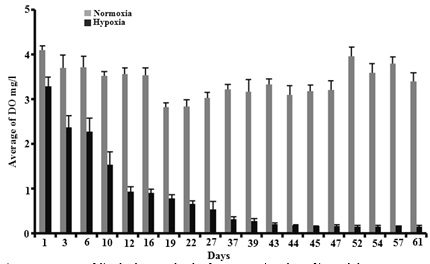International Journal of Fisheries and Aquatic Studies
Volume 1, Issue 2, 2013
Establishment of dry-down hypoxic stress treatment protocol for snakehead freshwater fish, Channa striatus
Author(s): S. D. Mohapatra, K. Kumar, P. Jayasankar, H. K. Barman
Abstract: The air-breathing fish, Channa striatus can survive in muddy and marshy water. It is a hypoxia tolerant species. Hypoxia tolerance linked investigations for large-bodied fishes are limited in the absence of suitable laboratory-protocol. Here, a dry-down approach for hypoxia treatment in FRP (fiberglass reinforced plastics) tanks containing pond-mud and freshwater was investigated for 61 days. This facilitated lowering of dissolved oxygen (~0.15 mg/L from 39 days) in hypoxic tanks compared to ≥3.5 mg/L normoxic tanks. Hypoxia exposed fishes preferred benthic habitat with reduced locomotives and hibernated under soft-mud, whereas normoxic fishes remained active with normal air-gulping. Lactate dehydrogenase, an anaerobic glycolytic enzyme, levels were elevated in serum, liver, muscle and brain of hypoxic fishes. The heightened hsp90β gene, a stress marker, expression in hypoxic fishes was also documented. Such striking differences on the behavioral and metabolic levels were indicative of successful hypoxia stress treatment. Thus, a laboratory-based rearing protocol for investigating long-term hypoxia stress tolerance in C. striatus was established. This will also have future implications in extending this protocol in other fish species.

A representation of comparative measurements of dissolved oxygen levels of water at various days of intervals between normoxic and hypoxic tanks. The DO levels were dramatically reduced around 39 days onwards in hypoxic tanks. The data represent the average DO level.
Download Full Article: Click Here
Journal is Indexed and Abstracted in following Database(s).
    |
    |
       |

